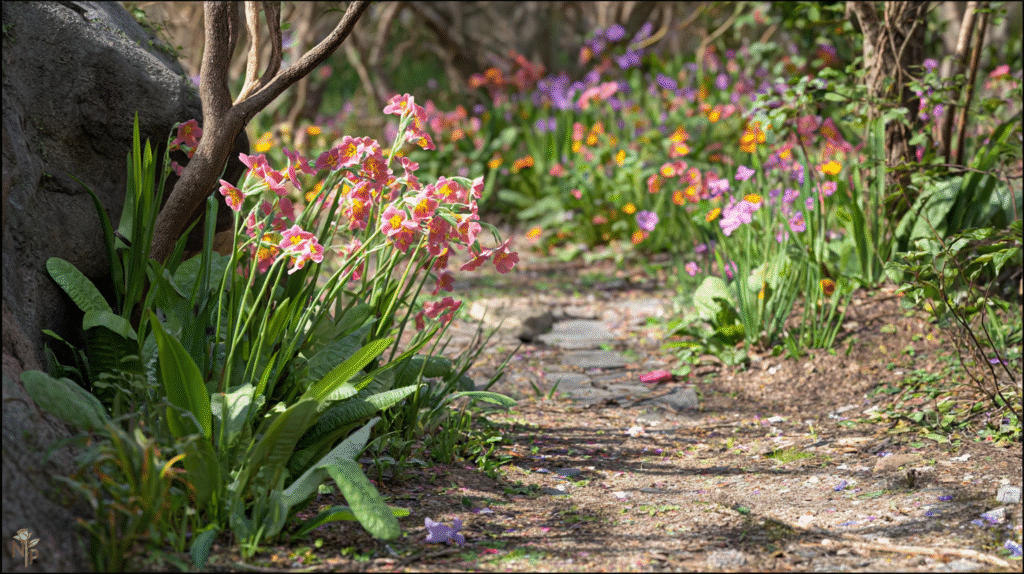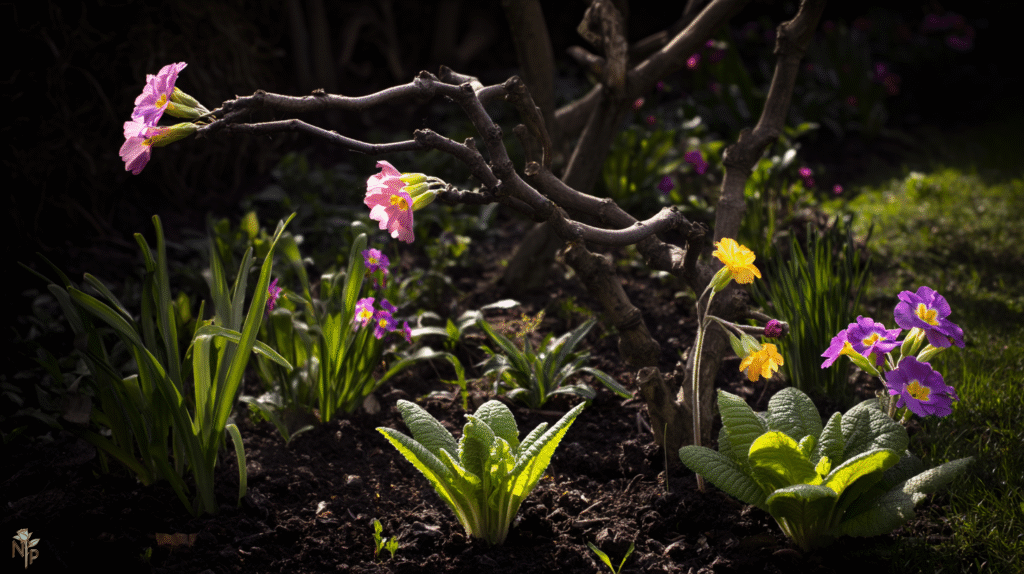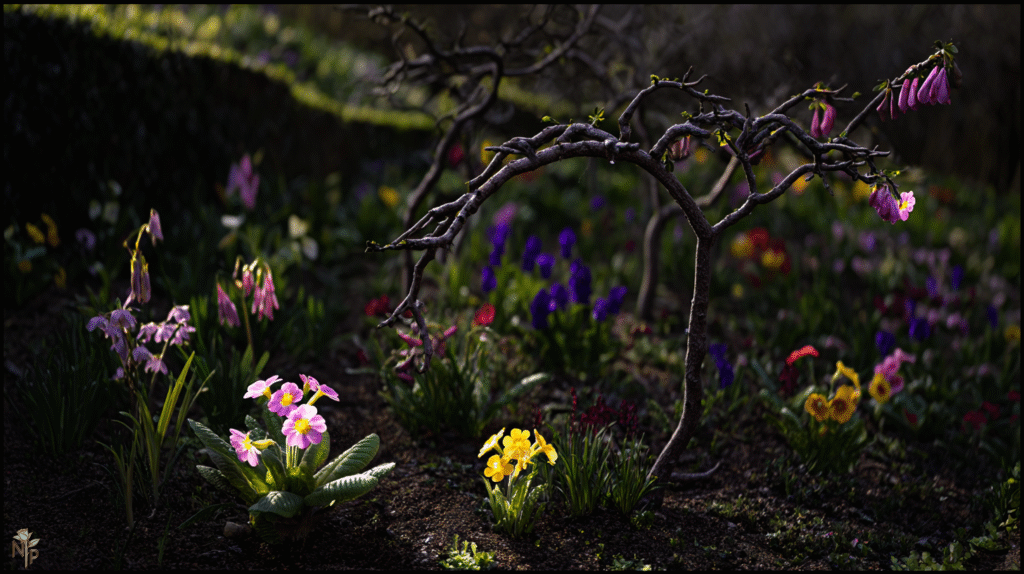My primrose education cost me about $200 and two years of spectacular failures. Every spring, I’d load up on those cheerful grocery store primroses — pink, yellow, purple beauties promising weeks of blooms. Every summer, I’d have a collection of crispy brown stumps that looked like someone took a blowtorch to them.
“They’re so easy!” everyone said. “Perfect for beginners!” they lied.
Turns out, primroses ARE easy — if you understand they’re basically the Goldilocks of the flower world. Too hot? Dead. Too sunny? Dead. Too dry? Super dead. But get their conditions just right, and they’ll bloom their faces off for months, come back every year, and make you look like a gardening genius.
After killing approximately 20 primroses (I kept buying them because I’m stubborn), I finally cracked the code. Now my primrose patch stops people on their morning walks. Here’s everything I learned about what these particular plants actually need versus what the care tags claim.

The Temperature Truth That Changes Everything
Here’s the game-changer nobody mentions: primroses hate heat. Not dislike. Not prefer cooler. HATE. They’re spring bloomers because they literally can’t handle summer.
The temperature sweet spot:
- Daytime: 50-65°F
- Nighttime: 40-50°F
- Death zone: Anything over 70°F consistently
My first breakthrough came when I finally understood this. Those grocery store primroses in March? They’re happy because it’s cool. By June when temps hit 75°F? They’re checking out. Not dying from disease or your bad care — just too damn hot.
What this means practically:
- Spring placement can be sunnier
- By late May, they need serious shade
- In hot climates, treat as cool-season annuals
- In mild climates, they’re perennials
I’m in Zone 6. My primroses live on the north side of my house where it stays coolest. The ones I planted in my “full sun perennial border”? Memorial services were held by July.
Light Requirements: The Moving Target
Primrose light needs change with temperature. This drove me crazy until I figured out the pattern.
Cool weather (under 60°F):
- Can handle quite a bit of sun
- Morning sun actually preferred
- Bright locations = better blooms
Warm weather (over 65°F):
- Need shade like they need water
- Dappled shade under trees ideal
- North side of buildings perfect
Hot weather (over 70°F):
- Deep shade or they’re toast
- Think woodland conditions
My successful primroses live under a dogwood tree. Spring sun comes through bare branches when it’s cool. Summer shade from leaves when it’s hot. Nature’s got it figured out — I just had to pay attention.

Soil: The Foundation I Got Wrong for Years
I kept planting primroses in my regular garden soil. Sandy, well-draining, perfect for most perennials. Primroses hated it.
What primroses actually want:
- Rich in organic matter (think forest floor)
- Moisture retentive but not waterlogged
- Slightly acidic (pH 6-6.5)
- Cool soil temperatures
My soil transformation: Before: Sandy loam that dried fast After: Added 3 inches compost, peat moss, and shredded leaves
The difference was immediate. Same variety that died in regular soil thrived in amended soil. It holds moisture without being soggy — exactly what primroses crave.
The mulch factor: 2-3 inches of shredded bark mulch keeps soil cool and moist. Game-changer in maintaining the conditions primroses need. I refresh it every spring.
Water: More Specific Than You Think
“Keep soil consistently moist” sounds simple. It’s not. I both overwatered and underwatered primroses before finding the balance.
What works:
- Soil should feel like a wrung-out sponge
- Never soggy (crown rot)
- Never dry (immediate wilting)
- Morning watering best
The finger test: Stick your finger in soil daily during blooming. Should feel moist but not wet at 1 inch depth. In my garden, that means:
- Spring: Every 2-3 days
- Early summer: Daily if still blooming
- Hot spells: Twice daily (morning and evening)
Water temperature matters: Cold water on hot days can shock them. I fill watering cans the night before to let water reach air temperature. Seems fussy? My primroses bloom two weeks longer than when I used hose water straight from the tap.
The Seasonal Strategy That Finally Worked
Understanding primroses’ seasonal needs transformed my success rate.
Early Spring (March-April):
- Can handle more sun and cooler soil
- Peak blooming time
- Feed lightly with balanced fertilizer
- Deadhead spent blooms religiously
Late Spring (May):
- Start providing more shade
- Increase watering as temps rise
- Keep deadheading to extend bloom
- Watch for heat stress
Summer (June-August):
- Deep shade essential
- Might go dormant (that’s okay!)
- Keep soil moist even if tops die back
- No fertilizer during stress/dormancy
Fall (September-October):
- Often get second smaller bloom
- Reduce watering as temps cool
- Add fresh compost around plants
- Perfect time to divide/transplant
Winter (November-February):
- Mulch after ground freezes
- No need to cover — they’re hardy
- Plan where to add more (addiction is real)

Varieties and Their Specific Needs
Not all primroses are equal. Two years of trials taught me:
English Primrose (P. vulgaris):
- Most cold-hardy
- Handles shade best
- Classic yellow easiest
- My reliable returner
Polyanthus Primrose:
- Showier flowers
- Slightly less hardy
- Needs more consistent moisture
- Better as annual in hot areas
Japanese Primrose (P. japonica):
- Loves wet spots
- Tallest type
- Latest bloomer
- Perfect for bog gardens
Drumstick Primrose (P. denticulata):
- Most heat tolerant (relatively)
- Unique ball-shaped blooms
- Earlier bloomer
- Good gateway drug for primrose addiction
Start with English primrose. Once you succeed, branch out.
Site Selection: Make or Break
My primrose graveyard taught me that location is everything:
Winners:
- North side of house foundation
- Under deciduous trees
- Along shaded pathways
- Near water features (cooling effect)
Losers:
- South-facing beds
- Next to heat-radiating pavement
- Windy, exposed spots
- Anywhere that bakes in summer
My most spectacular primroses grow where hostas thrive. If hostas are happy, primroses will be too. They’re companion plants in nature and in gardens.
Common Problems and Real Solutions
Leaves turning yellow:
- Usually too hot or too sunny
- Move to shadier spot immediately
- Might recover if caught early
Sudden wilting:
- Check soil moisture first
- If moist, probably heat stress
- Emergency shade (umbrella, cardboard) can help
No flowers second year:
- Probably too hot previous summer
- Needs better site
- Try drumstick variety (more heat tolerant)
Powdery mildew:
- Poor air circulation
- Water soil, not leaves
- Space plants properly
My Current Primrose Paradise
After all the failures, here’s what works:
The shady border: Under dogwood and redbud trees. Gets morning sun until 10 AM, then dappled shade. Amended soil stays moist. 15 English primroses thriving for three years.
The north foundation: Behind azaleas against house. Never gets direct sun. Polyanthus primroses return reliably. Blooms last longest here.
The bog garden edge: Where downspout creates moist spot. Japanese primroses naturalized themselves. Zero maintenance except admiring.
The Bottom Line on Primrose Success
Primroses aren’t difficult — they’re specific. Give them cool temperatures, appropriate shade, moist rich soil, and consistent water. Do this, and they’re actually easier than many “easy” plants.
My journey from primrose killer to primrose enthusiast took patience and dead plants. But now? Those cheerful blooms greeting spring make every failure worthwhile. Plus, nothing beats the satisfaction of growing something everyone says is easy after you’ve failed spectacularly first.
Start with one English primrose in your shadiest, coolest spot. When it thrives (and it will with right conditions), you’ll understand the addiction. Fair warning: you’ll end up planning your entire garden around keeping primroses happy. Worth it. 🌸






